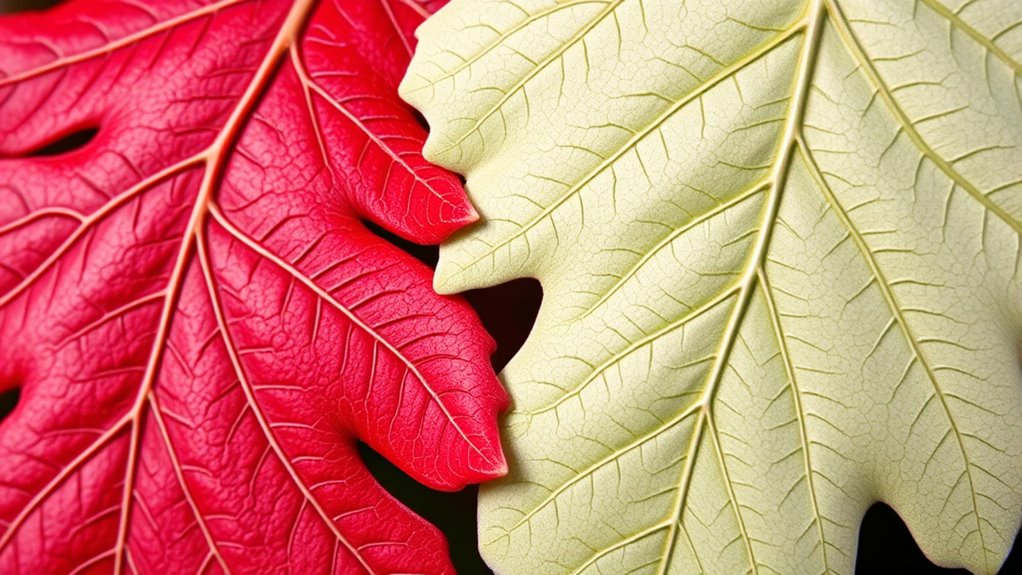To identify red versus white oaks, check the leaves first; red oak leaves have pointed, bristle-tipped lobes, while white oak leaves are rounded and scalloped. Feel the acorns—red oak shells are rough and gritty, typically smaller, whereas white oak shells are smoother and larger. Examine the bark—red oaks have dark, deeply ridged bark, while white oaks boast lighter, smoother furrows. Noticing these features can quickly clarify the species, and there’s more detail to help you differentiate further.
Key Takeaways
- Red oaks have pointed lobes with bristle tips; white oaks feature rounded lobes without bristles.
- Red oak acorns are smaller with rough, ridged shells; white oak acorns are larger and smoother.
- Red oak bark appears darker, rugged, with deep ridges; white oak bark is lighter, smoother, with shallow fissures.
- Red oak wood is harder with a reddish hue; white oak wood is lighter with a more uniform grain.
- Observe leaf margins, acorn textures, and bark features together for accurate species identification.

When choosing between red and white oak, understanding their key differences helps you make an informed decision. One of the easiest ways to distinguish these oaks is by examining their leaf margin differences. Red oak leaves typically have pointed lobes with sharp, bristle-tipped tips, giving them a more jagged appearance. In contrast, white oak leaves tend to have rounded lobes without the bristle tips, resulting in a softer, more scalloped edge. This subtle difference is often noticeable even from a distance, making it easier for you to identify the species in the field.
Beyond leaf margins, the acorn shell texture offers another clear distinction. Red oak acorns generally feature a rougher, more textured shell that feels gritty or ridged to the touch. These acorns are usually smaller, which can help you identify the tree during the fall when they’re on the ground. White oak acorns, on the other hand, tend to have a smoother, more polished shell that’s less textured. Their shells are often larger and more rounded, making them easier to differentiate from red oak acorns. Recognizing these shell textures helps you quickly identify the species without needing to examine other parts of the tree.
The bark of the two species also varies but isn’t as immediately noticeable as leaf and acorn differences. Red oaks often have darker, more rugged bark with deep ridges and furrows, while white oaks typically display lighter, smoother bark with shallow fissures. These features develop with age, so they’re more apparent on mature trees.
When it comes to wood use and aesthetic choices, these differences matter too. Red oak wood tends to be harder with a reddish hue, making it popular for furniture and flooring. White oak, with its lighter color and more uniform grain, is often selected for cabinetry and barrels. Recognizing these characteristics can guide you whether you’re selecting trees for landscaping, woodworking, or simply trying to identify what species you’re observing.
Frequently Asked Questions
How Do Oak Species Differ in Their Growth Rates?
You’ll notice that red oaks generally have a faster growth rate comparison, reaching maturity quicker than white oaks. Red oaks can grow about 2-3 feet per year, while white oaks tend to grow more slowly, around 1-2 feet annually. This difference affects oak maturity timelines, with red oaks maturing in about 40-50 years, whereas white oaks may take 60-100 years to fully develop.
What Are the Common Pests Affecting Red and White Oaks?
Did you know that over 400 pest species can threaten oaks? Red and white oaks face common pests like oak wilt, gypsy moths, and oak leaf miners. These pests can substantially impact growth, weakening trees and making them vulnerable to disease. Effective pest management strategies include regular inspections, proper pruning, and targeted insecticides. By staying vigilant, you can protect your oaks from damage and ensure healthy growth.
Can Red and White Oaks Hybridize Naturally?
Yes, red and white oaks can naturally hybridize through oak hybridization, allowing genetic exchange between the species. You might notice hybrid oaks in areas where their ranges overlap, creating trees with mixed traits. This natural process occurs when pollen from one species fertilizes the ovules of the other, leading to hybrid offspring. Understanding this helps you appreciate the genetic diversity and complexity within oak populations.
Which Oak Species Are More Drought-Resistant?
Red oaks are generally more drought-resistant than white oaks because they have better drought adaptation and water efficiency. You’ll notice red oaks can withstand dry conditions better due to their deeper root systems and tougher bark. White oaks may struggle more in prolonged droughts, but they still adapt reasonably well. If you’re planting in an area with limited water, choosing red oaks can give you a more resilient and sustainable landscape.
How Do Oak Species Vary in Their Decay Resistance?
They say, “Forewarned is forearmed,” and knowing oak decay resistance helps you choose wisely. You’ll find white oaks generally resist decay better than reds, thanks to tighter grain and higher tannin content. Environmental decay factors like moisture and fungi influence this difference. White oaks’ superior decay resistance makes them ideal for outdoor use, while red oaks may require more protection to endure over time.
Conclusion
Just as the wise old trees in ancient myths held secrets in their rings, your ability to distinguish red from white oak deepens your connection to nature’s silent stories. By recognizing their unique traits, you become a guardian of these living monuments, understanding that each tree, like a chapter in a timeless book, has its own tale. Embrace this knowledge, and you walk in the footsteps of those who truly listen to the whispers of the forest.









